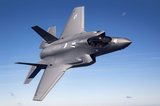US Air Force awards nearly $1 billion for hypersonic missile
The US Air Force is awarding almost $1 billion to Lockheed Martin to design and develop a hypersonic missile that can be launched from a warplane.
The contract follows repeated warnings from senior defence officials about rapid advances by China and Russia in the field of hypersonic weaponry, where missiles can fly at many times the speed of sound and dodge missile-defence systems.
On 18 April, the Pentagon said Lockheed will receive up to $928 million to build the new, non-nuclear missile it is calling the ‘hypersonic conventional strike weapon.’
The statement read: ‘This contract provides for the design, development, engineering, systems integration, test, logistics planning, and aircraft integration support of all the elements of a hypersonic, conventional, air-launched, stand-off weapon.’
On 19 April, Mike Griffin, the Pentagon's new defence undersecretary for research and engineering, said China had built ‘a pretty mature system’ for a hypersonic missile to strike from thousands of kilometres away.
He said: ‘We will, with today's defensive systems, not see these things coming.’
Hypersonic weapons can beat regular anti-missile defences as they are designed to switch direction in flight and do not follow a predictable arc like conventional missiles, making them much harder to track and intercept.
Russian President Vladimir Putin in February 2018 claimed to have developed a new type of hypersonic missile that is impervious to any Western shield.
Gary Pennett, director of operations at the Missile Defence Agency, recently said enemy hypersonic weapons -- which could be launched from planes, ships or submarines - would create a ‘significant’ gap in US sensor and missile interceptor capabilities.
The MDA has asked for $120 million to develop hypersonic missile defences, a big increase from the $75 million in fiscal 2018.
More from Defence Notes
-
![Ireland spells out $2.3 billion shopping list in five-year defence spending plan]()
Ireland spells out $2.3 billion shopping list in five-year defence spending plan
Ireland’s multi-annual investment in capital defence spending is set to rise from €300m in 2026 to €360m in 2029–2030 with major upgrades across land, air, maritime and cyber domains.
-
![Canada set to look away from its neighbour and across the Atlantic for partners]()
Canada set to look away from its neighbour and across the Atlantic for partners
While non-EU UK struggles to join the Security Action for Europe initiative, which provides loans for defence programmes, Canada has become the first country outside Europe to get access – and did so for a nominal fee.
-
![NATO experiments with solutions to integrate networks, AI and uncrewed systems]()
NATO experiments with solutions to integrate networks, AI and uncrewed systems
During the latest edition of the NATO DiBaX, the alliance tested multiple capabilities to inform requirements for future efforts.
-
![Leonardo unveils plans for Michelangelo air defence dome]()
Leonardo unveils plans for Michelangelo air defence dome
The new multi-layered defence system will harness AI to neutralise airborne threats and protect Europe from Russian aggression.
























